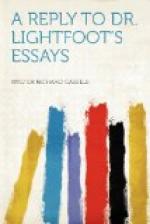My statement [31:2] is, that it is admitted that there was no such place as Sychar—I ought to have added, “except by apologists who never admit anything”—but I thought that in saying: “and apologetic ingenuity is severely taxed to explain the difficulty,” I had sufficiently excepted apologists, and indicated that many assertions and conjectures are advanced by them for that purpose. I mention that the conjecture which identifies Sychar and Sichem is rejected by some, refer to Credner’s supposition that the alteration may be due to some error committed by a secretary in writing down the Gospel from the dictation of the Apostle, and that Sichem is meant, and I state the “nickname” hypothesis of Hengstenberg and others. It is undeniable that, with the exception of some vague references in the Talmud to a somewhat similar, but not identical, name, the locality of which is quite uncertain, no place bearing, or having borne, the designation of Sychar is known. The ordinary apologetic theory, as Dr. Lightfoot may find “in any common source of information,”—Dr. Smith’s “Dictionary of the Bible,” for instance—is the delightfully comprehensive one: “Sychar was either a name applied to the town of Shechem, or it was an independent place.” This authority, however, goes clean against Dr. Lightfoot’s assertion, for it continues: “The first of these alternatives is now almost universally accepted.” Lightfoot [32:1] considered Sychar a mere alteration of the name Sichem, both representing the same place. He found a reference in the Talmud to “Ain Socar,” and with great hesitation he associated the name with Sychar. “May we not venture” to render it “the well of Sychar”? And after detailed extracts and explanations he says: “And now let the reader give us his judgment as to its name and place, whether it doth not seem to have some relation with our ‘well of Sychar.’ It may be disputed on either side.” Wieseler, who first, in more recent times, developed the conjectures of Lightfoot, argues: “In the first place, there can be no doubt that by [Greek: Suchar] Sichem is meant,” and he adds, a few lines after: “Regarding this there is no controversy amongst interpreters.” He totally rejects the idea of such in alteration of the name occurring in translation, which he says is “unprecedented.” He therefore concludes that in [Greek: Suchar] we have another name for Sichem. He merely submits this, however, as “a new hypothesis to the judgment of the reader,” [32:2] which alone shows the uncertainty of the suggestion. Lightfoot and Wieseler are substantially followed by Olshausen, [32:3] De Wette, [32:4] Hug, [32:5] Bunsen, [32:6] Riggenbach, [32:7] Godet, [32:8] and others. Bleek, [32:9] in spite of the arguments of Delitzsch and Ewald, and their Talmudic researches, considers that the old town of Sichem is meant. Delitzsch, [32:10] Ewald, [32:11] Lange, [32:12] Meyer, [32:13] and others think that Sychar was near to, but distinct from, Sichem. Luecke [33:1] is very




